A recent study shows that Italian culture influences Mafia games since Italian characters are often represented as stereotypical members of Mafia in games as well as in movies. Characters have greasy hair, a propensity for violence, wearing fancy suits, and communicate with stereotypical nonverbal and verbal gestures.
Researcher Giuroso Pitroso’s study “Mafia and the representations of Italians” analyses the representations of Italians and the Mafia in video games. Pitroso used Moby Games, YouTube and Steam to find games that include Italian Mafia and played them. Games that were unavailable he watched from YouTube. Pitroso selected games such as Grand Theft Auto III, Gangsters 2: Vendetta, The Godfather, Mafia II and Omerta: The City of Gangsters.
Mafia games recreate stereotypes of Italians and Mafia, and games are influenced strongly by Mafia themed movies. Movies play a major role in the way Mafia is depicted in video games. For example, the video game Gangsters 2 had Al-Capone’s face on the cover and Omerta and Chicago 1930 has an atmosphere of prohibition.
The strongest stereotype linked to Italians in video games is the one connected to the Mafia. Italian Mafia themed games are often influenced by Mafia or gangster movies, if not created from them. The first mobster game was The Godfather by US Gold from 1991 for the Atari ST, Amiga and MS-DOS. It is based on Francis Ford Coppola’s The Godfather movie series, which had an important role in creating models and stereotypes of Sicilian Cosa Nostra. Coppola didn’t approve of video games based on his movies. He thought that video game is a misuse of film series.
The Godfather is not the only one that represents Mafia as a normative Italian family structure. The video game Guns, Gore and Cannoli present a mobster that survives in the middle of a zombie apocalypse. The main character uses stereotypical Italian body language and idiomatic expressions, like “Forget about it!” and “Capish?”. Characters related to the Italian Mafia, have often revenge, vendetta as a mission.
Italian characters are also linked to a specific type of music. For example, in Grand Theft Auto III by Rockstar, the Italian mobsters listen to fictional radio channel Double Clef FM, which plays Italian opera music.
Games also represent patriarchal structures. Female characters usually play a secondary role in Mafia themed games. Prostitutes, dancers and other female characters’ roles are mere to pleasure the main characters, which are usually males. Women are part of the natural family, which is often less important than the family related to organized crime, La Famiglia.
According to Pitroso, Mafia games are at risk firstly of criminalizing an ethnic group. Secondly, they can legitimatize organized crime and the Mafioso lifestyle. Italians are not the only ethnic group that has been represented as second class citizens or purely criminals. Mexicans are represented as bandits, native Americans as bloodthirsty savages and African Americans as uninhibited wild men.
Representing Mafia stereotypes have changed from 90’ and ’00s. Games such as Mafia III shows racism experienced by Lincoln, the Mafia outcast. Lincoln is African American and underlines the problem of racism in Mafioso culture. There is still interesting research to do. Pitroso presents further possible research questions, like how the games are perceived by gamers.
